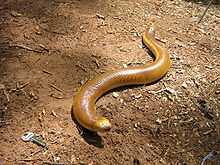Amphisbaenidae
| Amphisbaenidae | |
|---|---|
 | |
| Amphisbaena alba | |
| Scientific classification | |
| Kingdom: | Animalia |
| Phylum: | Chordata |
| Class: | Reptilia |
| Order: | Squamata |
| Clade: | Amphisbaenia |
| Family: | Amphisbaenidae |
| Genera | |
|
17, see text | |
The Amphisbaenidae are a family of amphisbaenians, commonly known as worm lizards.
Geographic range
Amphisbaenids occur in South America, some Caribbean islands, and in Sub-Saharan Africa.
Taxonomy
One deep-branching and somewhat aberrant genus, Blanus, is native to Europe, and may represent a distinct family.[1]
Description
Members of the family are limbless, burrowing, lizards with carnivorous diets. As in other amphisbaenians, the body bears rings of scales, which gives amphisbaenids a worm-like appearance. The heads are massively constructed and used for burrowing, with powerful jaws and large, recurved teeth used for seizing prey. Some species have spade-like heads, while others have a narrow keel on their heads, and still others have a rounded skull.[1] The eyes are highly reduced, while the ear bone, or stapes, is large and massively built. Together with another bone, the extracollumella, the stapes is used to detect vibrations of prey items, allowing amphisbaenids to be able to hunt for invertebrate underground.
Genera
Over 120 species are in the family, grouped into 17 genera:
- Amphisbaena Linnaeus, 1758
- Ancylocranium Scortecci, 1930
- Anops Bell, 1833
- Aulura Barbour, 1914
- Baikia Gray, 1865
- Bronia Wiegmann, 1828
- Cercolophia Strauch, 1881
- Chirindia Boulenger, 1907
- Cynisca A.M.C. Duméril & Bibron, 1839
- Dalophia Gray, 1865
- Geocalamus Günther, 1880
- Leposternon Hemprich, 1820
- Loveridgea Tornier, 1899
- Mesobaena Mertens, 1925
- Monopeltis A. Smith, 1848
- Zygaspis Cope, 1885
References
- ↑ 1.0 1.1 Gans, Carl (1998). Cogger, H.G., & Zweifel, R.G, ed. Encyclopedia of Reptiles and Amphibians. San Diego: Academic Press. p. 216. ISBN 0-12-178560-2.
Further reading
- Gans, C. 2005. Checklist and Bibliography of the Amphisbaenia of the World. Bull. American Mus. Nat. Hist. (289): 1-130.
External links
| Wikispecies has information related to: Amphisbaenidae |